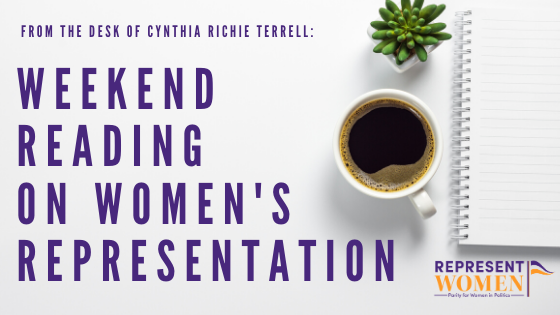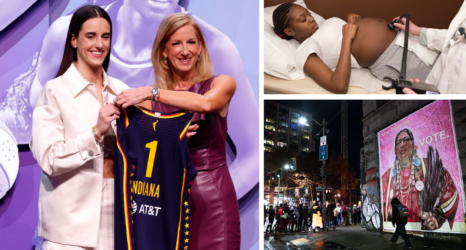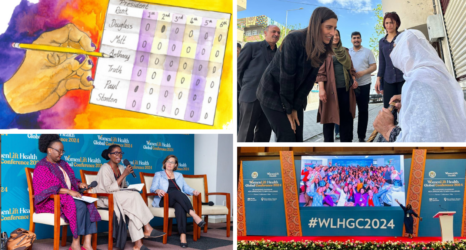
Weekend Reading on Women’s Representation is a compilation of stories about women’s representation in politics, on boards, in sports and entertainment, in judicial offices and in the private sector in the U.S. and around the world—with a little gardening and goodwill mixed in for refreshment!

Amidst the news of the continuing pandemic and wide-spread protests of police violence there were some incredible victories for women candidates running for offices at the local, state, and federal levels this week.
Jennifer Medina wrote an article in The New York Times about the election of Ella Jones as mayor of Ferguson six years after a police officer shot and killed Michael Brown:
Ella Jones became the first African-American and first woman elected mayor in Ferguson, Mo., on Tuesday, nearly six years after the city erupted in protests after a white police officer shot and killed Michael Brown, a black teenager, propelling Ferguson into the national spotlight and galvanizing the Black Lives Matter movement.
The victory for Ms. Jones, a Ferguson City Council member, came as another night of protests unfolded throughout the country over the killing of George Floyd and persistent police brutality against black Americans.
Ms. Jones, 65, and her opponent, Heather Robinett, 49, had both vowed to continue changes enacted after the 2014 shooting of Mr. Brown, including a federal consent decree, a legally binding agreement requiring reforms to a police department.
And both had made clear that they supported peaceful protests after the killing of Mr. Floyd in Minneapolis, while condemning the violence that has broken out in several cities.

A woman will likely become mayor of Baltimore, according to this article from the Baltimore Sun—and several women were elected to the D.C. City Council on Tuesday, including Janeese Lewis George, whose campaign was run by RepresentWomen board member Michelle Whittaker.
There was a story in The Washington Post about her victory written by Fenit Nirappil and Julie Zauzmer that features the names of the men who lost— not the woman who won.
Despite this faux pas, it’s a good outcome for women’s representation, and young women in particular:
D.C. voters upended city hall politics in Tuesday’s Democratic primary, ousting an ally of Mayor Muriel E. Bowser in favor of an insurgent left-leaning candidate and ending the political career of a veteran lawmaker tarred by scandal.
D.C. Council member Brandon T. Todd (D-Ward 4) lost his reelection bid to Janeese Lewis George, a lawyer and self-identified democratic socialist who had been endorsed by her former employer, D.C. Attorney General Karl A. Racine (D).
In affluent Ward 2, voters decisively rejected Jack Evans’s attempt to reclaim the seat he held for nearly three decades before resigning amid an ethics scandal earlier this year.
The winner of the Ward 2 nomination remained unclear Wednesday, with former Racine policy staffer Brooke Pinto and Foggy Bottom neighborhood commissioner Patrick Kennedy separated by 100 votes, according to unofficial returns. Mail-in ballots postmarked by Tuesday will be counted as long as they are received by June 12.
There were additional primary wins for women of color across the U.S. in elections held this week, according to this article in The New York Times that profiles Teresa Leger Fernandez—a terrific ally on voting system reforms including ranked choice voting. New Mexico could have an all-women of color delegation to the House of Representatives in November:
Iowa, which mailed absentee ballot request forms to every registered voter, had the largest turnout for a June primary in the state’s history, according to Paul Pate, the secretary of state. In Montana, which mailed ballots to all registered voters, total turnout was up 35 percent compared with the state’s 2016 primary. Turnout was up 14 percent in New Mexico and 12 percent in South Dakota, despite few competitive races there.
The primary results in New Mexico reflected a significant shift. In the Democratic contest for a House seat representing the northern part of the state, Teresa Leger Fernandez, a progressive with deep roots in New Mexico, easily defeated Valerie Plame, the former C.I.A. agent.
Ms. Leger Fernandez is widely expected to prevail in November in her staunchly Democratic district. Her victory would mean New Mexico could have a House delegation that entirely comprises Hispanic and Native American women.
Representative Deb Haaland, a Native American elected to Congress in 2018 to represent the district encompassing Albuquerque, is expected to hold her seat.
And in the southern part of the state, Representative Xochitl Torres Small, a Hispanic first-term Democrat, is running for re-election against Yvette Herrell, who won the Republican primary. Ms. Herrell is an enrolled member of the Cherokee Nation.

Students at MIT have a elected Danielle Geathers as president of the Undergraduate Association. Geathers is the first Black woman to hold this position, according to this story on CNN:
Danielle Geathers and running mate Yu Jing Chen won the student government election earlier this month.
Geathers just finished her sophomore year at MIT and is majoring in mechanical engineering. She served as the diversity officer last year.
“In terms of coming from that diversity space and being focused on promoting equity across MIT, it would kind of be important to have someone in the President’s role who’s focused on that,” she said.
She said she plans to use her platform to make the school as inclusive as possible. “Although some people think it is just a figurehead role, figureheads can matter in terms of people seeing themselves in terms of representation,” she said. “Seeing yourself at a college is kind of an important part of the admissions process.”

Sharon Waxmen, a great ally and CEO of The Wrap, offers her take on the events that have unfolded this week, along with a link to a piece on Marie Claire by Bianca Rodriguez about documentaries to watch to educate ourselves about racism:
We have learned the history and watched the tape over and over. Our entertainment community has held this mirror up to the country, with eloquence. Ava DuVernay showed us the continuum of black persecution in this country with her 2016 documentary “13th” about mass incarceration, and again with her dramatic depiction of unjust conviction in last year’s “When They See Us.”
Other works—like “Just Mercy” in 2019 and “The Hurricane” in 1999 or “Mississippi Burning” in 1988—should have guided the path to a just society.
We thought April was the cruelest month. But week after week, we see our nation descending into ever worse low points.
For those who believe this is a tipping point, I will remind them that tipping points are seen in hindsight, not in real time. To tip is to sacrifice and lean into the hardship, because what’s at stake is worth it. The stakes before us are clear: the fate of our democracy. Our character as Americans. The price we are willing to pay to be the nation we aspire to be.

There was also a important read by Radha Friedman on Medium about norms in the non-profit community and organizations that are led by women of color:
I’ve worked on intersectional gender equality issues for two decades, and I get a lot of questions. Questions like, “Which organization is doing the best work on racial and gender equity?” or “Where should I donate?”
It’s a tricky question, because there isn’t one answer.
Part of my work involves asking questions that require deep reflection. How does your power and privilege show up? What is the unfinished work you have to do? What example do you want to set for your children or nieces and nephews or any young person in your life, so that you don’t have to explain to them how this injustice could have happened during your lifetime? How can you use your resources to heal the historical harm that has been done?
Everyone’s answers are different, and there are 1.6 million nonprofits in the U.S. alone.
Because of this, many people feel overwhelmed, so they wait or are paralyzed and do nothing.
Here’s the thing: Doing nothing is a choice, just as much as choosing where to invest your money. And doing nothing is a privilege we cannot afford.
From local soup kitchens to domestic violence shelters, hundreds of thousands of organizations are contributing to equality — racial equality, gender equality, disability equality, LGBTQI equality, immigrant and refugee equality, or intersectional equality.
But these organizations are not equal. Nonprofits are still 80% white led. Even fewer have women of color in leadership. In 2016, only 0.6 percent of foundation giving was targeted to women of color.

Women’s representation milestones this week include the anniversary of Sojourner Truth’s “Ain’t I A Woman” speech given at the Women’s Rights Convention in Akron, Ohio, in 1851, here is the text of that speech:
Well, children, where there is so much racket there must be something out of kilter. I think that ‘twixt the negroes of the South and the women at the North, all talking about rights, the white men will be in a fix pretty soon. But what’s all this here talking about?
That man over there says that women need to be helped into carriages, and lifted over ditches, and to have the best place everywhere. Nobody ever helps me into carriages, or over mud-puddles, or gives me any best place! And ain’t I a woman? Look at me! Look at my arm! I have ploughed and planted, and gathered into barns, and no man could head me! And ain’t I a woman? I could work as much and eat as much as a man – when I could get it – and bear the lash as well! And ain’t I a woman? I have borne thirteen children, and seen most all sold off to slavery, and when I cried out with my mother’s grief, none but Jesus heard me! And ain’t I a woman?
Then they talk about this thing in the head; what’s this they call it? [member of audience whispers, “intellect”] That’s it, honey. What’s that got to do with women’s rights or negroes’ rights? If my cup won’t hold but a pint, and yours holds a quart, wouldn’t you be mean not to let me have my little half measure full?
Then that little man in black there, he says women can’t have as much rights as men, ’cause Christ wasn’t a woman! Where did your Christ come from? Where did your Christ come from? From God and a woman! Man had nothing to do with Him.
If the first woman God ever made was strong enough to turn the world upside down all alone, these women together ought to be able to turn it back , and get it right side up again! And now they is asking to do it, the men better let them.
Obliged to you for hearing me, and now old Sojourner ain’t got nothing more to say.

On June 4, 1919, the 19th Amendment—which prohibited the federal government from denying anyone the right to vote based on their gender—passed in the U.S. Senate. The Amendment was officially adopted on August 26, 1920, after Tennessee became the 36th state to ratify the measure.

The countdown to the celebration of the centennial of suffrage and the virtual Seneca Falls Revisited conference continues this week with a thoughtful blog by Maura Reilly on the influence of Haudenosaunee women on the movement for women’s suffrage:
As we celebrate the suffrage centennial this year and remember the many women leaders and suffragists who helped to get us to where we are today, it is important to remember the women who inspired the women’s suffrage movement. While many point to the great work done by suffragists like Susan B. Anthony, Lucretia Mott, Elizabeth Cady Stanton and the other organizers of the 1848 Seneca Falls Convention, Dr. Sally Roesch Wagner (PhD), author of Sisters in Spirit, points to their source of inspiration for gender equality, the Haudenosaunee matriarchy.
The early suffragists had many formal and informal connections and interactions with the people of the Six Nations Confederacy, often referred to as the Iroquois but who self-identity as the Haudenosaunee or “The People of the Longhouse.”
Dr. Roesch Wagner (PhD) illustrates the similarities between the Triumvirate’s idea of a matriarchate and the structure of Haudenosaunee social organization, in which women chose the Chief, were able to hold political office, had a say in forming a consensus, controlled property, had spiritual authority and responsibility, and children belonged to their mother’s clan.
In her book Sisters in Spirit, Roesch Wagner suggests the early suffragists “believed women’s liberation was possible because they knew liberated women, women who possessed rights beyond their wildest imagination: Haudenosaunee women.”
In the U.S., women can now own property, vote, run for office, and maintain custody of their children in the case of divorce. All successes made possible by both the famed suffragists and their inspiration the Haudenosaunee women, who are often forgotten in our narrative on women’s suffrage.
Despite the many victories suffragists and feminists have won for women in the U.S., success has been uneven and incomplete especially for women of color, and the Native women who inspired the goals of the suffragists. In 2018, Deb Haaland (NM-01) and Sharice Davids (KS-03) became the first Native American women elected to Congress. Although nearly five million Native women living in the U.S. only two have ever served in the House of Representatives and none have served in the Senate.
Native women and all women of color continued to face a disproportionate number of obstacles, but the first female Principal Chief of the Cherokee Nation, Wilma Mankiller provides us with a good start to correct these seemingly insurmountable disadvantages, “look forward, turn what has been done into a better path.” A better path forward includes Native women in leadership positions, be it at the local, tribal or national level.

I joined the protest at the Capitol on Monday of this week. It felt good to be part of such a large, socially distancing and thoughtful crowd—including this family of five.

Remember to check out this week’s must-reads from the team at RepresentWomen.






